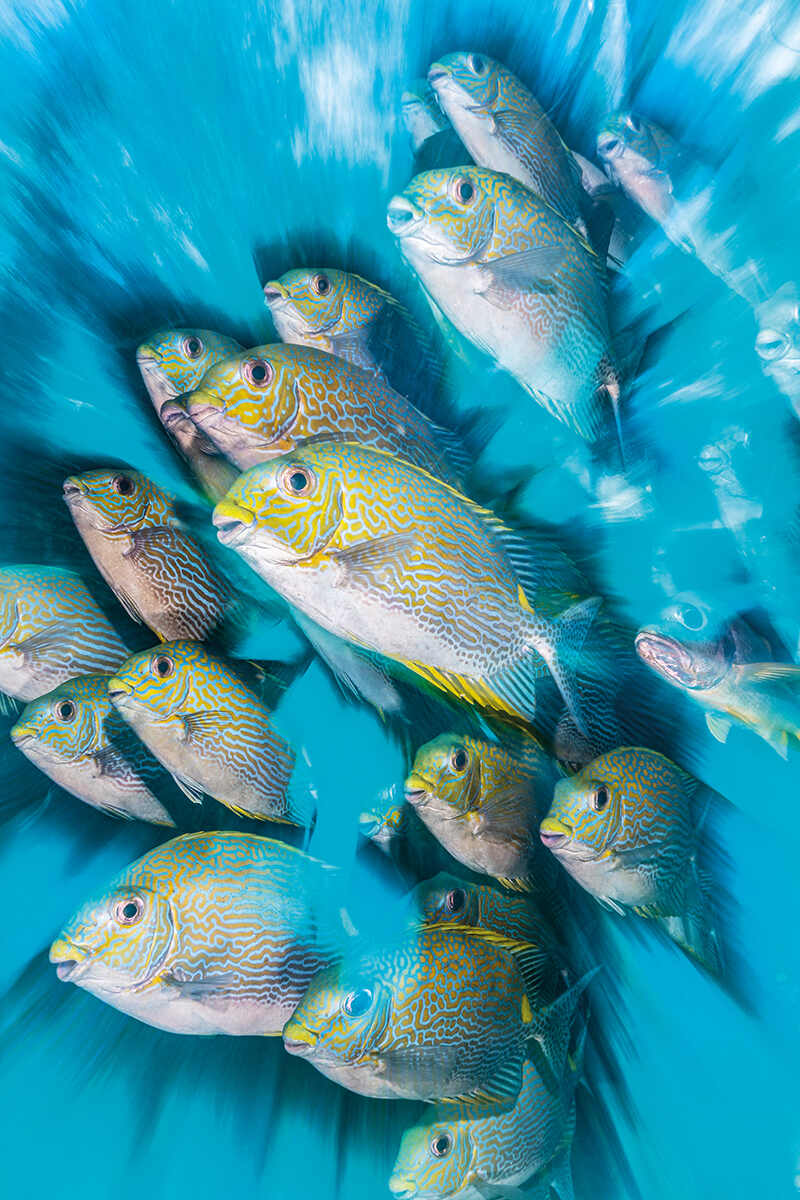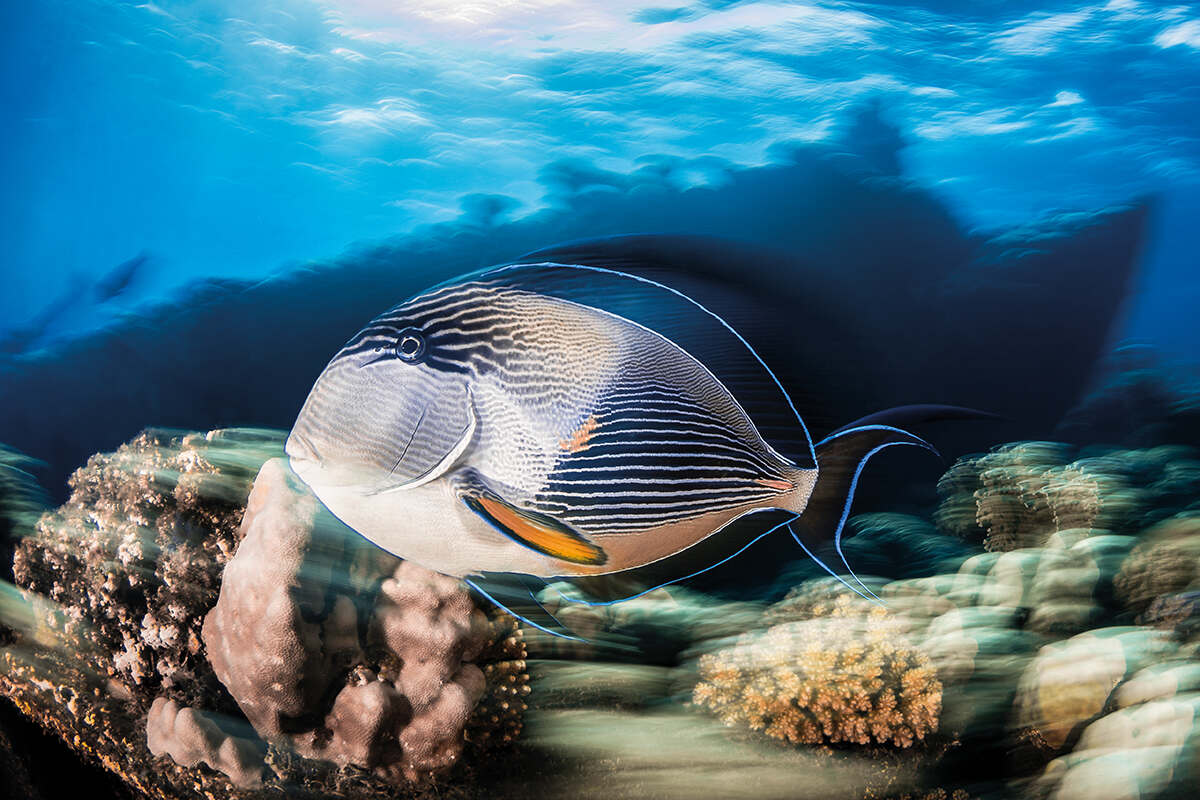
Award-winning underwater photographer Nick More explains how to take motion blur images
In many ways, photography is a trick – a glorious ruse which makes us believe that what we see on the page or the screen is real. Photographers strive to create images that seem to be honest representations of the natural world. Viewers rely on a series of complex assumptions to process what we see, and believe it to be a truthful image. But these are conventions and what we accept to be natural is, of course, a fabrication. Now and again something comes along which confounds the conventions and brings new life to how we represent the wonder of the natural world. Often, it is a mix of technological developments and artistic vision which nudges those flat, two-dimensional series of ink dots on a page, or pixels on a screen, into a vibrant new way of telling stories. The current fad for motion blur images is one such revolution. These images capture an element all divers are familiar with – the fluid, endless motion that makes the world below the surface so dynamically different from topside landscapes. The technique brings the underwater world alive. The master of motion blur is Nicholas More, who has won a string of awards and plaudits for his striking photographs. Here, he explains some of the techniques he uses to blur the marine world to help bring it into focus.

Calamari blur
I took this panning shot of a bigfin reef squid on a night dive in Lembeh Strait, Indonesia, using front curtain sync and a slow shutter speed. I used a high-power torch in conjunction with the flash to bring out the colour of the squid. The blur was achieved by accelerated panning through the exposure. When using this technique, you frame the subject and start panning at the speed it is travelling, then hit the shutter. At that point the flash will go off and you start to accelerate the panning ahead of the subject. Squid use a siphon (clearly visible in this shot, just under its eye) to propel themselves through the water to evade predators and catch prey. The technique emphasises the dynamic nature of these animals.
Essential terms
• Panning – a photographic technique that combines a slow shutter speed with camera motion to create a sense of speed around a moving object.
• Accelerated Panning – moving the camera with, and then ahead of, the subject to create blur effects.
• Motion Blur – is the streak-like effects of moving objects in a photograph.
• Front Curtain Sync – default mode of the camera, the flash is triggered at the beginning of the exposure.
• Rear Curtain Sync – the flash is triggered at the end of the exposure.
• Exposure Triangle – the balanced relationship between shutter speed, aperture and ISO. A change in one of these must be compensated by a change in at least one other.
• Shutter Speed – the amount of time the camera’s sensor is exposed to light. The slower the shutter speed, the more blur is achieved (typically between 1/6th and 1/15th sec).
• Aperture – refers to the diameter of the opening of the lens through which light passes.
A high aperture (for example. f/20) is a small opening that controls the flash brightness needed to freeze the subject.
• ISO – this setting controls the sensitivity of the camera’s digital sensor. A low ISO balances the slow shutter speed needed to blur images (for example ISO 100).
• Strobes – Underwater flashguns – the more powerful, the better, for motion blur photography.
• Ambient Light – also known as natural light. The light from the sun.

Tube sponge swirl
Yellow tube sponges, Grand Cayman. Here, I used front curtain sync with a slow shutter speed. First I composed the shot, then I rotated the camera during the exposure to blur the background to an attractive swirl while maintaining the subject in sharp focus. This technique creates a separation of the subject from the busy reef, so the tube sponges can take centre stage.

Rabbit punch
A zoom-blur shot of a school of rabbitfish under a jetty in Raja Ampat, Indonesia. I used a slow shutter speed with front curtain sync, while simultaneously zooming the lens from wide to telephoto during the exposure. The blurred ambient light that frames the subjects gives the image a pop art feel. This picture earned me the title of British Underwater Photographer of the Year 2020.
xxxx

Hammer time
A great hammerhead shark portrait taken during a baited shark feed in Bimini in The Bahamas. I used a slow shutter speed with front curtain sync, in conjunction with accelerated panning to capture the mayhem, dynamism and energy of the shark feed – all within a single frame.

Moving masterpiece
I was completing my safety stop during a dive in the Red Sea when this bluespotted stingray swam under me. I already had my settings dialled in, so I was able to capture this unique image. I used a slow shutter speed combined with accelerated panning and front curtain sync. This had the effect of blurring the distracting background but also causing the blue spots to run, rather like an oil painting.
Tips and tricks
• Shoot in manual. Also shoot in RAW, as you will probably need to make some adjustments post-production (including reduction of highlights and increases in contrast, vibrance and clarity).
• Use a slow shutter speed (1/4 – 1/15th sec) to allow the ambient light to blur the image.
• Use high-power flashguns (strobes). Be prepared to turn your flashguns to full for big animals. It is the flash that freezes the subject so that it appears sharp in the frame.
• Use a large aperture (f/18 – f/22) and a low ISO (50-200).
• On modern cameras, use Group AF function. Consider locking the focus (manual) on older cameras with slower AF systems.
• Shoot at the beginning or the end of the day, when the light levels are low. Try to shoot with the sun, rather than against.
• Get close to your subject – the flash will not light subjects that are more than a metre away.
• Choose dynamic subjects, such as sharks.
• Try different techniques such as spins, twirls and zoom-blurs. Or even combine the different techniques to get wacky results.
• Practise! For every successful motion blur shot, there are at least ten failures.
• Commit to the technique and plan entire dives or even trips dedicated to the style. The images will boost your portfolio as well as being appealing to judges in photo competitions.
• Tighten the clamps on your strobe arms. The motion of panning underwater can move your flashguns due to the water resistance.

Guardian of the wreck
Surgeonfish, such as this one I came across near the Chrisoula K wreck in the Red Sea, aggressively defend their algae gardens. I used a slow shutter speed and front curtain sync with panning to capture the moment, while framing the wreck in the background to give context to the image.

Cutting edge
Razorfish school together and feed in an upright position. When they move to a new feeding spot, they swim in a diagonal formation. I found this school during a dive in Lembeh Strait, Indonesia. I used a slow shutter and front curtain sync, to capture them in motion.

Heading for cover
Turtles come to the surface to breathe. Once they have taken a gulp of air, they zoom back down to the reef for protection. I used a slow shutter speed and front curtain sync with a panning movement to capture this green turtle heading back to the reef at Misool in Raja Ampat, Indonesia.

Blue streak
This blue shark was photographed using a slow shutter speed and accelerated panning with front curtain sync, during a baited shark feed in Cornwall, UK. I framed the shark against the RIB and the surface to give depth and context. This image won the overall Grand Prize at the British Society of Underwater Photographers Print Competition in 2017.

Batfish seismograph
The house reef at Misool in Raja Ampat, Indonesia was festooned with baitfish. Predators were causing the school to bunch together and explode in formation when attacked. I used a slow shutter speed and rear curtain sync (RCS), then moved the camera up and down during the exposure to create this effect. With RCS the strobes fire at the end of the exposure. This allows motion blur to be captured on moving foreground subjects, but keeps the background relatively sharp. The downside to this technique is that you’re not fully in control of the composition, because the subject can be erratic and might not swim through the frame as expected. I took more than 50 frames to achieve the desired effect.

The vortex
I was lucky enough to witness a huge school of bigeye jacks, just off Scuba Seraya beach, Tulamben, Bali, Indonesia. They were being hunted by a huge, giant trevally. This caused them to bunch tightly together forming a massive rotating vortex. The slow shutter speed, combined with accelerated panning and front curtain sync, captures this dramatic event.

The swarm
A mass of baitfish was sheltering around a red fan gorgonian at Two Tree Island, Raja Ampat, Indonesia. These tiny fish would all of a sudden swarm together to evade predation from hunting jacks. I used rear curtain sync to frame the sea fan, then waited for the baitfish to swim into frame. The slow shutter captures the energy of this fast-moving event.

Lurking pike
Pike are freshwater ambush predators, they lie in wait in the algae waiting for potential prey. I found this one in Stoney Cove in the UK. This slow-shutter-speed panning shot using front curtain sync emphasises the pike’s patience, while giving an indication of its potential speed. This picture was commended in the Underwater Photographer of the Year 2019.


